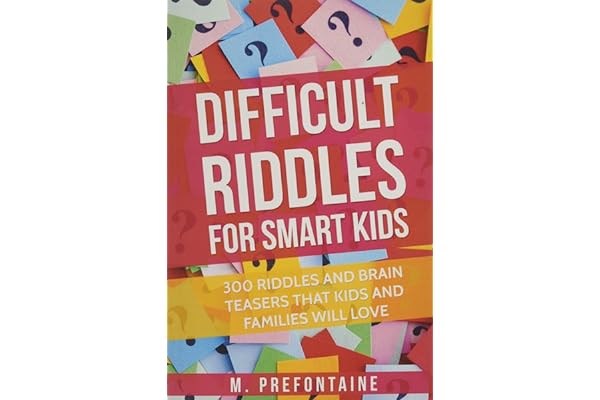One sentence summary
M Prefontaine’s ‘Difficult Riddles For Smart Kids: 300 Difficult Riddles And Brain Teasers Families Will Love (Thinking Books for Kids)’ is a fun challenge for children and parents alike to flex their mental muscles with mentally stimulating riddles and brainteasers.
Book Genre
This book is a Puzzle & Activity Book.
Main topic of the book
The main topic of this book is puzzles and riddles geared towards children, aged 5 to 12, to improve their problem-solving abilities and critical thinking skills.
Key ideas
The key ideas in M Prefontaine’s book include:
- Critical Thinking: Through riddles, brain-teasers, and games, children are encouraged to think logically and develop their problem-solving skills.
- Mental Agility: Young minds will be challenged as the riddles and brainteasers presented become increasingly more difficult as the book progresses.
- Fun Learning Environment: Questions and puzzles are presented in a fun and positive learning environment that encourages children to learn and explore.
Main parts of the book and a short summary
M Prefontaine’s ‘Difficult Riddles For Smart Kids’ is divided into six sections, each containing 50 unique riddles and brainteasers:
- Logic Puzzles: Logic puzzles are designed to test the child’s ability to solve problems by recognizing patterns and employing deductive and inductive reasoning.
- Word Puzzles: Word puzzles are designed to test the child’s ability to recognize relationships between words and to decipher hidden meaning in sentences.
- Number Puzzles: Number puzzles are designed to test the child’s ability to identify numerical relationships and employ various mathematical concepts.
- Visual Puzzles: Visual puzzles are designed to test the child’s ability to visualize and manipulate objects in their mind’s eye.
- Reasoning Puzzles: Reasoning puzzles are designed to test the child’s ability to make rational decisions and think logically.
- Memory Puzzles: Memory puzzles are designed to test the child’s ability to recall details and remember patterns.
Key takeaways
At the end of each section of the book, Prefontaine presents a list of ‘key takeaways’ that remind the reader of the important skills and abilities the riddles and puzzles are designed to enhance. These key takeaways are presented in the form of brief summaries and concise bullet points, making them an excellent reference for both the parent and the child.
Author’s background and qualifications
M Prefontaine is a teacher, researcher, and author with over 10 years of experience in the education sector. He holds a PhD in cognitive science and specializes in designing and developing educational tools and material to help children learn more effectively.
Target audience
The target audience for this book are children aged 5-12 who are looking to expand their general knowledge, develop their mental agility, flex their mental muscles, and challenge themselves with puzzles and riddles.
Publisher and first publication date
M Prefontaine’s ‘Difficult Riddles For Smart Kids: 300 Difficult Riddles And Brain Teasers Families Will Love (Thinking Books for Kids)’ was first published by Mangrove Publishing in 2020.

